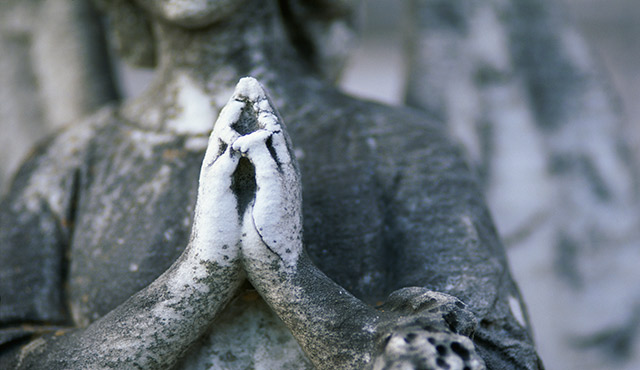The man lay, resting and fully awake in his hospital bed, when he had his otherworldly experience.
“All of a sudden, I was jerked into an utterly lucid state of awareness. I was sitting up in the bed staring intently into the darkness, although in fact I knew my body was lying flat.”
In front of him was “a color like blue and purple vaguely in the form of hanging draperies,” and next to that he saw two “presences.” Without words, they conveyed the message that “Everything is ready now.”
Richard John Neuhaus, a Catholic priest and founder of the Institute for Religion and Public Life, didn’t die that night. But he is certain that, based on his religious conviction and knowledge, that the “presences” were angels.
“I understood that they were ready to get me ready to see God,” he writes in his 2000 essay, “Born Toward Dying.”
Did Father Richard really see angels who were going to guide him toward God? Or was his experience neurological or psychological in origin? Maybe he was just hallucinating.
Thousands of reported near-death experiences (NDEs) include sensations such as detachment from the body, a feeling of being levitated, complete serenity and the presence of a bright light, among other characteristics. But are NDEs real?
It’s impossible to discuss near-death experiences from a Catholic perspective without looking at it from an overall Christian point of view. In addition, any exploration of NDEs cannot be made without discussing the existence of the afterlife in general.
The Christian grounds for believing in an afterlife are in the Bible, says Dr. Carol Zaleski, professor of world religions at Smith College in Northampton, Mass., and the author of “Otherworld Journeys: Accounts of Near-Death Experience in Medieval and Modern Times” and “The Life of the World to Come.”
“We’re all created in the image of God,” Zaleski says, “and the suggestion is that God does not want to see his creations come to nothing. God wishes to see his creations flourish and endure, and God has the power to have that happen.” (This view, she adds, is shared among Jews and Muslims.)
The key for Christians, says Zaleski, is the life, death and resurrection of Jesus. “It’s the essential basis for hope for life to come after death for all of us. When you die, your soul persists.”
This belief in the afterlife – and, by extension, near-death experiences – is provided in Scripture. One example, says Zaleski, is in the Letters of St. Paul. He talks about how Christ was raised from the dead: “Just as we all die in Adam, so we will all rise in Christ.”
Current Catholic teachings on death and the afterlife can be found in the “Letter on Certain Questions Concerning Eschatology,” published by the Congregation for the Doctrine of the Faith in May 1979; and a longer document, “Some Current Questions in Eschatology,” published in 1992 by the International Theological Commission. These two documents conclude that the soul is immortal, says Zaleski, and that “the fullness of the life to come will be the resurrection of the whole person. But before that happens, the souls of the [departed] loved ones can be thought of as alive.”
But where does this leave Catholics in a secular world rooted in scientific inquiry and empirical proof? Can Scripture and faith coexist with neurology and psychology? After all is said and done, might NDEs still have a scientific origin?
Catholicism is, and always has been, comfortable with the scientific inquiry of “private revelations” such as claims of near-death experiences, says Zaleski, since the faith is already so grounded in what Scripture has to say about the afterlife. However, people without scriptural faith tend to lean too heavily on the scientific approach. A secular scientist who sees no evidence of NDEs must conclude that they simply cannot exist. End of discussion.
Catholics, however, take the middle path between total faith and complete nonbelief.
“The Catholic view states, ‘Yes, we believe in life after death. We don’t reject this, nor do we reject personal testimony.’ But you don’t use personal testimony as the basis for the belief in an afterlife,” says Zaleski. “It’s a middle path between complete skepticism and blind faith.”
A priest who counsels a parishioner’s claim of a near-death experience can use this measured approach to help the person see things from more than one point of view. (This applies to someone who has had any kind of mystical experience.)
For example, says Zaleski, “If the person seems to be more loving and more hopeful and in tune to [his] faith, then it might not be a time to bring up all of the neurological or psychological explanations. But if another person [reporting a near-death experience] is going off the deep end, you’d want to caution him and lead him back to the mainstream sources.”
When it comes to near-death experiences, says Zaleski, the bottom line is religious faith: “When you’re part of a fully developed religious tradition, you don’t need perfect scientific evidence that there’s life after death. It’s already well-documented.”

